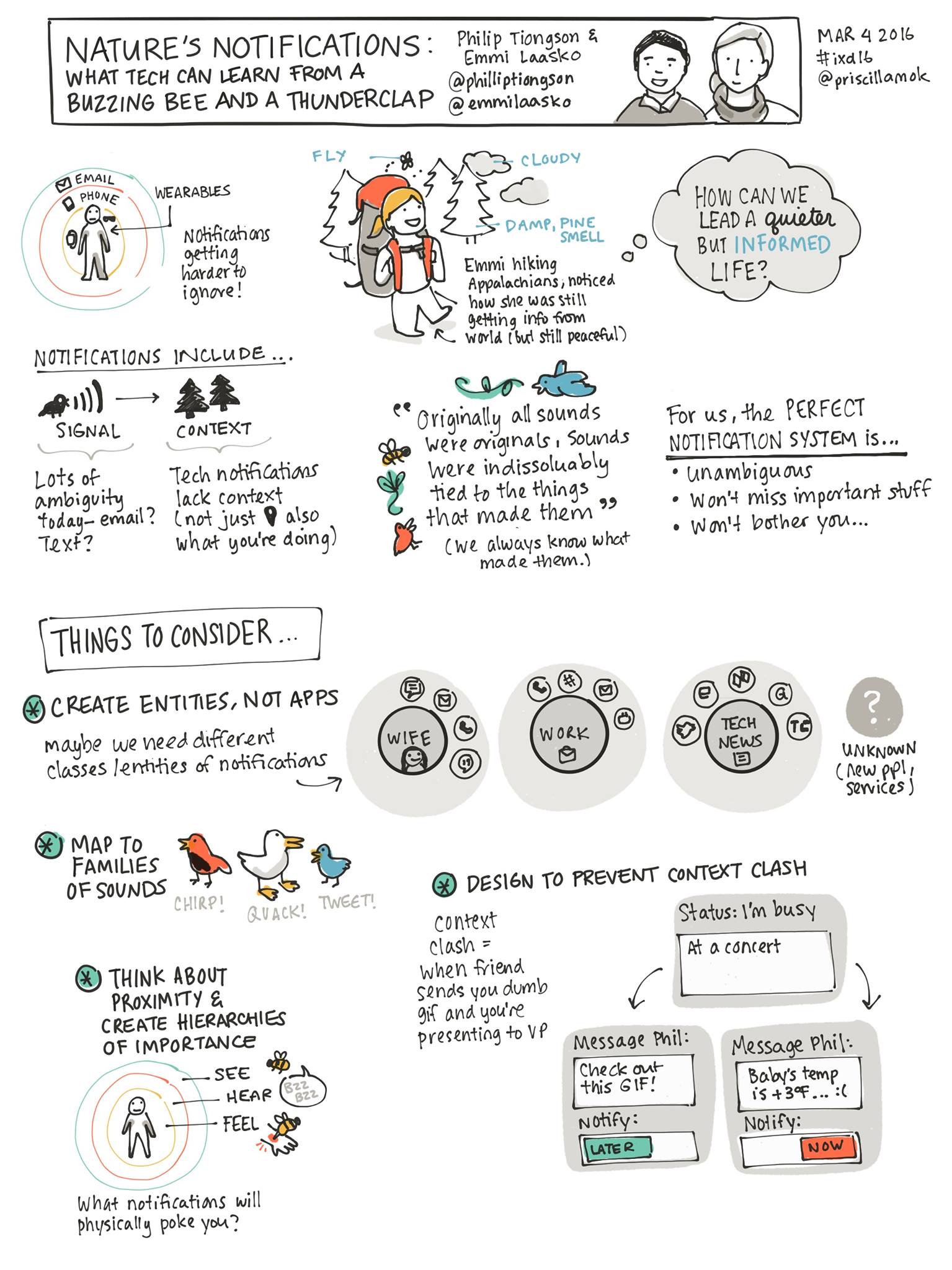My co-worker said something about the value of notifications I thought was absolutely brilliant:
It’s like we’re trying to convince the whole world they have a cold because we’re selling tissues.
But really we’re selling them tissues with snot already in it.
To put it so much less poetically, a lot of the services we offer boast being able to ‘stay in touch’ or receive notifications as a perk, but maybe everyone is fighting over a way to design something that no one wants.
Services be like: We only send important notifications—the notifications you care about….Wait! Wait, don’t go!—How many notifications is too many? When is a good time? Now? Is it now? Now?
There’s this design dream about being able to create these ‘just-in-time’ notifications that seamlessly intercept you in a helpful way. For instance, say you’re at the grocery store just about to get in line to check out and you receive a notification that says “don’t forget the tarragon!” The day is saved and you go back swing back around to get it.
To break this down, this means designing an experience where this service knows…
- Where you are. (the grocery store)
- What you need at that location. (your grocery list)
- What you had already gotten from your list. (but you’re missing the tarragon! Drats on that non-staple item!)
- That it was definitely out-of-mind. (you were heading towards the check out counter)
(Important Spoiler: I am not going to propose an actionable a solution! I just want to unload all these disconnected thoughts I’ve had on notifications)
This is the story that I’ve heard people tell, teary-eyed with the beauty of the what they have just created. And it’s quite a feat to be admired! You have this system that understand physical context, your schedule, micro-behavior, and timing.
Oh, timing! they’ll emphasize, if you can just slip in at that perfect moment you can have such a satisfying notification!
If I get that notification too early, I’m annoyed that it’s baby-ing me. Another alternative is that it gives you a notification when you’ve just past the tarragon aisle, which some people might prefer, but that would fall into the baby-ing category for me. If it comes once I’ve left the store (detects a location change) it’s too late and I’d still have to turn back. If it doesn’t present the precise information (just the tarragon) then I’m apt to be like “great, it’s a long list of items, I’m pretty sure I got all the things”—which, let’s be real, is still what I do when I’m holding a physical list in my hands the whole time. It’s more of a security blanket than an actual cue-card. If we want that notification to bring ‘delight’ to a user, we only need to find the perfect time, they say.
Not to be down on notifications, I think the idea of these eMom-notifications are spiffy, I guess I’ve just been thinking how notifications are a really interesting problem and that maybe you would too.
My friend sent me this beautiful sketch-notes of a design lecture she attended.
Some pretty neat ideas, right? Something that stood out to me was the proposal in the bottom right. It reminded me of the time well spent project that I talked about before. The general idea is that instead of designing for the ability to ‘always be connected’ (and to always be able to connect to people) we should be designing for a way to respect our and other people’s time. For example, maybe you want to send tell Nancy some Things, but she is heads-down trying to finish her own project.
Tristan Harris’ example:
Nifty, right? Nancy has set a status to ‘focused,’ you are made aware of her status as you type, and your messages are put in queue accordingly. She’ll be able to get back to them when she’s good and ready.
How this works in real life: If you were like me and ever set your status in Skype, Facebook messenger, Hangouts, or AIM (yes, AIM!) to be best one, it was always to ‘invisible’ or ‘busy’ mode regardless of what was going on because you wanted to lurk and and chat with your friends whenever you pleased. It was our work around for keeping the world out when we really only wanted to talk to each other, our friend group.
But if you did take status seriously, as the authors suggest, and you’ve off-loaded the responsibly of the notification to the contactee. You’re asking them to make a judgement if what they have to say to their friend, co-worker, boss, or crush is “important” enough to interrupt them. That doesn’t seem reflect a truly social way of designing, does it? You’ve increased the friction to contact—which was an intentional good—but you put the contactee in this awkward position of questioning the importance of what they have to say, their self-worth, and most probably their undergraduate major. You don’t know how to design this perfect notification, but maybe a human will be better at it. (They totally are better at it).
But even though people are better at making judgements about their message, ultimately, other people won’t know what Nancy wants to hear and when. Maybe she would get sad that someone wanted to ask her for help but didn’t because she said she was busy. Or her project really frustrates her and it would have been nice of her husband to have interrupted and say “I love you!”. Or she feels left out when her team gets lunch without her because they don’t want to disturb her.
So then, you will tell me, what if you let people be invisible and just thumbs-up-thumbs-down these notifications like a spotify playlist and eventually our service will learn what you want! We actually already love being invisible and stalking other people’s lives over social media, this is just the next natural extension: finding the patterns in what you actually want to see or not (Facebook does this already, of course).
Because for me, personally, a helpful notifications would respond to my my patterns (though that’s pretty neat to see on a chart!), it would smooth the process when there are deviations from it. Goodness knows I don’t need help remembering routines (that doesn’t even make sense), it’s obviously when I have to remember to get the tarragon that I’ll need some help. This not a new idea. But one that people often overlook. Do I need to know what the traffic report is every day? No, only if it’s irregular. But dang it if Google Now isn’t trying to tell me otherwise!
What’s the most important, most favorite, or your most useful notification you get in a day?
Mine? It’s still my alarm clock, which notifies me —aggressively—of the time.
That’s it.
With all this access to other information: my step count, the news in Europe, my best friend’s new Instagram post, the results of the election, the thing I still want to know the most is the time.
Time is precious. So maybe the next innovation of time-telling is telling your time. Giving a Fenton-esque view of how you spend your time, who you spend your time with, how much of your time is spend happy and how much of it is spent in despair. Over a day, a week, a year, a lifetime to look back at. You start seeing things to schedule instead of just seeing your schedule: I need to make time for reading that book, or calling my mom.
I don’t have a way to end this disjointed post. Goodbye!


